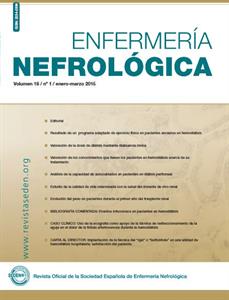Contenido del artículo principal
Resumen
Por los profesionales del campo de la Nefrología y la Diálisis es conocida la vital importancia de contar con un acceso vascular óptimo desde que en 1945 se realizase el primer tratamiento renal sustitutivo con hemodiálisis. Esto es debido a que la calidad del acceso vascular (AV) condiciona la eficiencia y efectividad de dicha técnica, así como la morbilidad y calidad de vida de los pacientes sometidos a esta terapia1. Para que un AV sea considerado óptimo debe reunir varias características: permitir el abordaje seguro y continuado al sistema vascular, proporcionar flujos suficientes que permitan suministrar la dosis de diálisis requerida y carecer de complicaciones. Sin embargo, a pesar de que, en la actualidad, este tipo de AV no existe, el que más se acerca a estos requisitos es la fístula arteriovenosa interna (FAVI)1. Por ello, se considera el acceso vascular de elección en los pacientes con insuficiencia renal crónica terminal que requieren hemodiálisis. La evidencia científica coincide en la importancia de los cuidados enfermeros efectivos de la FAVI y de una técnica de punción adecuada para conseguir el correcto desarrollo y permeabilidad, prolongar su supervivencia y minimizar las complicaciones relacionadas con la disfunción (estenosis, aneurismas, trombosis, infección...). El correcto uso y mantenimiento de este acceso vascular (AV) va a ser la piedra angular relacionada con el aspecto técnico de la hemodiálisis en el que la enfermería puede incidir. Se ha comprobado que la técnica de punción de la FAVI es motivo de ansiedad y disconfort para el paciente y, secundariamente para el personal del enfermería2. Además de influir en la supervivencia de la FAVI, dado que las punciones repetidas acaban alterando la morfología y características del vaso sanguíneo3, como ya enunció Kronung en 1984 con su análisis de las consecuencias de las múltiples punciones, y la mejor técnica para evitar su daño4, debido a la elongación de la pared frontal del vaso provocada por el desplazamiento del tejido y al posterior llenado con un trombo del hueco generado tras la retirada de la aguja.
Palabras clave
Detalles del artículo
Aviso de derechos de autor/a
© Los autores ceden de forma no exclusiva los derechos de explotación de los trabajos publicados y consiente en que su uso y distribución se realice con la Licencia Creative Commons Atribución - No comercial 4.0 Internacional (CC BY-NC 4.0). Puede consultar desde aquí la versión informativa y el texto legal de la licencia. Esta circunstancia ha de hacerse constar expresamente de esta forma cuando sea necesario.




